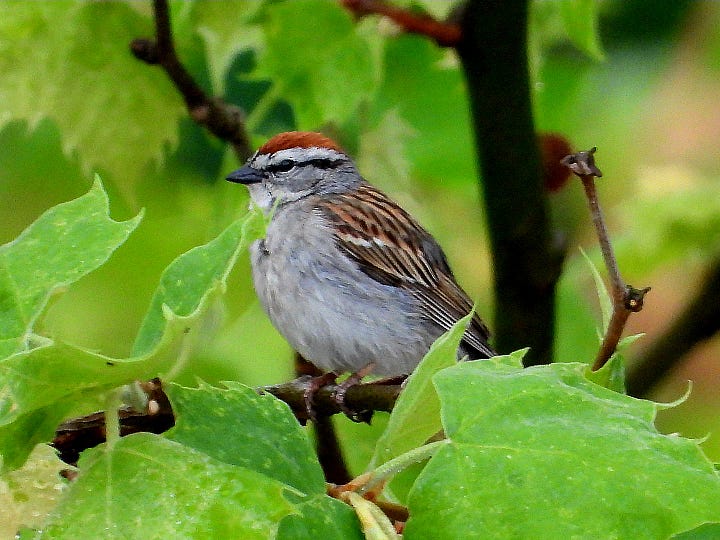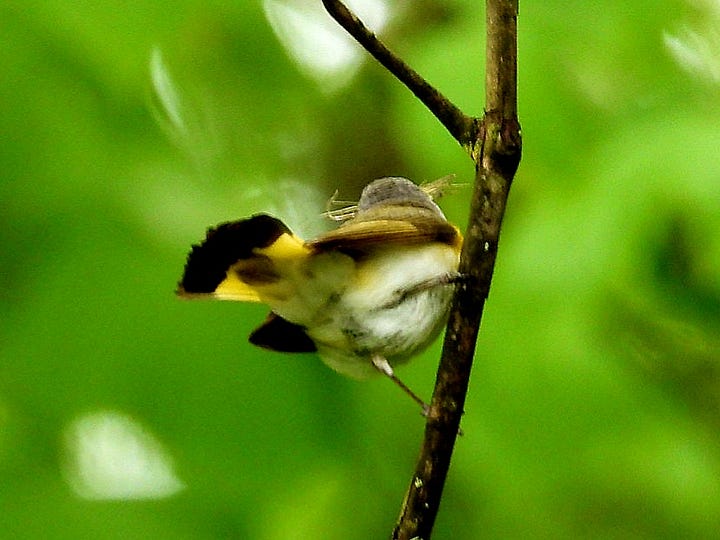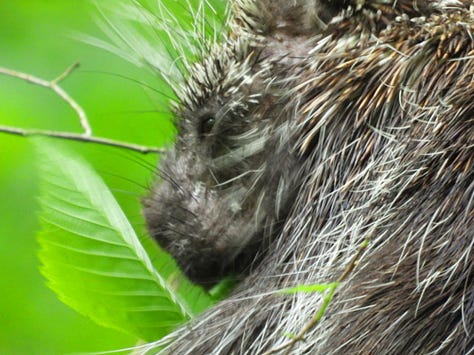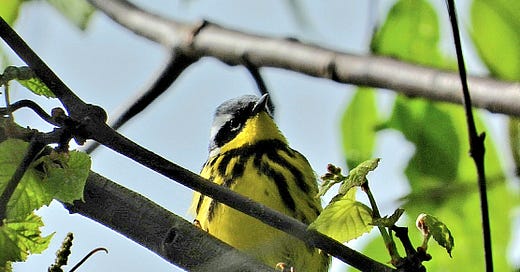Highlights
Bobolink and Semipalmated Sandpiper - NFC FOYs (Tues AM)
Philadelphia Vireo - Mountaintop FOY (Tues)
Least Bittern - NFC FOY (Tues PM)
Common Nighthawk, Lincoln’s Sparrow, and Prairie Warbler - Mountaintop FOYs (Thurs AM)
Semipalmated Plover (FOY) and Sora on NFCs (Fri PM)
Mourning Warbler and Pectoral Sandpiper (NFC FOYs, Sat AM); Yellow-bellied Flycatcher (Mountaintop FOY)
Vesper Sparrow (NFC FOY, Sun AM) and Northern Waterthrush (FOY along the tracks, Sun AM)
Thousands of NFCs, a mysterious rail, and sandpiper songs on Mon PM/Tues AM
Cliff Swallow pair along the river (Tues PM)
Common Ravens feeding recently fledged young above vernal ponds (Fri AM)
Big Day in May (International Migratory Bird Day) - Saturday - 111 species
Biggest Weekend at Plummer’s Hollow (Fri - Mon): 125 species
Saturday highlights: fallout of transient species including almost all warblers; Yellow-breasted Chat seen; Solitary Sandpiper at the pond; American Coot (first-ever seen in hotspot) at the bridge
River of Swallows (all weekend)
184 species in the hotspot for 2024 (#4 in Pennsylvania)
Notable misses: Eastern Kingbird, Lesser Yellowlegs, terns, Blue-winged Warbler, Great Egret, Bonaparte’s Gull, Hooded Merganser, Northern Shoveler, Blue-winged Teal
Targets remaining for May: Italicized above + Willow Flycatcher, Alder Flycatcher, Henslow’s Sparrow, Dickcissel
Other 200+-spp. targets for 2024: Upland Sandpiper, Short-billed Dowitcher, Whimbrel, Ruddy Turnstone, Black-bellied Plover, American Golden-Plover, Blue-winged Warbler, Connecticut Warbler, Northern Saw-whet Owl, Evening Grosbeak, American Black-Duck, Snow Bunting
Nemesis Bird: Olive-sided Flycatcher
Disappearing acts: Red-breasted Nuthatch, Golden-winged Warbler
Log
May 6 (Mon). AM/PM: 49 spp. (balcony, 2.5 hrs.)
May 7 (Tues). AM: 65 spp. (0.25-mi. hike + drive, 1 hr.); PM: 50 spp. (1.5-mi. hike, 1 hr. 40 min.)
May 8 (Wed). AM: 38 spp. (balcony, 1 hr. 20 min.)
May 9 (Thurs). AM: 82 spp. (1-mi. hike + drive, 3 hrs.)
May 10 (Fri). AM: 40 spp. (1.8-mi. hike, 1 hr. 40 min.)
May 11 (Sat). AM/PM: 103 spp. (7-mi. hike, 8.5 hrs.); PM: 29 spp. (balcony, 1.5 hrs.)
May 12 (Sun). AM: 77 spp. (3.5-mi. hike, 3 hrs.)
A week of chilly, downright horrendous weather punctuated with torrential downpours and high water (again) on the Little J kept the flood of tropical transients mostly pinned down through the Biggest Weekend. Very few species slipped through undetected, thanks in no small part to the pollinator insects swarming the black cherry flowers. If the five-days-ahead trend continues, the migratory peak will quickly pass and the transients will evaporate with cold fronts to come next week.
All the Regulars Are Back
After ferreting unusual species out of the deepest woods and tangles over the last several days, it’s a blessing to work on the balcony with a leisurely count going on in the background. Over the course of a few Monday noontime hours, all the expected edge-of-town species from the last few years show up, including, at last, a vigorously singing Yellow Warbler. Territories are being carved out and defended against all rivals. First broods of some species are ready to fledge, while others are barely getting started.
Today, I learn the scold of the Warbling Vireo, one of the least-often seen species in the hotspot, but one that almost never is quiet during this time of year. At one point, a Red-shouldered Hawk, rare visitor from out of town, flies in from the east, causing a minor uproar among the swifts and swallows. Meanwhile, Chipping Sparrows are either courting or fighting on the gravel in the parking lot, and close to 1 PM, a Black-throated Green Warbler starts up its buzzy song from distant trees in the confluence. This could either be a new transient, late in the season for the species, or an unlucky male who could not grab a prime breeding territory up in the mountains.
Against the dizzyingly green hillslope of Bald Eagle, I watch the spectacular attack of an American Crow on a Turkey Vulture. It’s too far away to hear anything, but the crow seems quite angry at the vulture, diving and ripping at it repeatedly as the much large bird swoops in a surprisingly graceful upward spiral to evade the corvid. The crow peels off after sending the vulture on its way off down the ridge.
Sandpiper Songs
On Monday night, the floodgates are released with a favorable northerly wind. Within a few minutes of the last crepuscular noise—towhee reeps and whip-poor-will bars—the first nocturnal flight call, a Wood Thrush’s veet, is picked up. Over the next hours, thousands more calls are recorded, sometimes overlapping each other—Ovenbirds, American Redstarts, Chestnut-sided, Cape May, and myriad other warblers up above 6 kHz, thrushes and Rose-breasted Grosbeaks low, cuckoos lower, and interspersed with the seemingly endless chuckles, growls, whistles, and trills of the local chat. Every few minutes, a Field Sparrow or an Ovenbird does a night song, while Scarlet Tanagers as well as grosbeaks occasionally sing full songs in flight.
The thousands represent a fraction of the close to a million birds passing over the county tonight (according to BirdCast), a fraction close enough to be heard and that vocalize in flight (as many apparently do not). Shorebirds are particularly active, with Solitary and Spotted sandpipers stretching their typical two- to four-note calls into lengthy songs more often heard only on breeding grounds. Semipalmated Sandpipers seem farther away (probably higher up) but also make the 2024 list. The first clear Bobolinks go over, one of many NFC-only species for which the hotspot does not have adequate stopover or breeding habitat.
At 2:35 AM, what looks and sounds like the kek-churr of a King Rail, but may only be a call of the common Virginia Rail, registers clearly:
(Any Rallid experts out there are welcome to weigh in, as I’m stumped.)
As yet ignorant of any of this, I scour the field at dawn for new species and am pleasantly surprised by a Philadelphia Vireo popping up in the same protruding tangle in which it appeared last year, also several days early.
In the evening, a pair of Cliff Swallows forage above the river, hopefully the pair that nests under the HWY 453 bridge. This species has been quite scarce in 2024, and doesn’t appear to have set up shop closer to the balcony, as one did last year (mud nest stuck up under the I-99 overpass).




Grackle Hatch
Wednesday’s balcony dawn is bustling with Common Grackle noise and activity that appears to signal that nestlings now occupy many of the nests inside the tangled, sodden mass of leafy vegetation overhanging the banks of Bald Eagle Creek and the Little Juniata River downstream from their confluence.
After rains again (what else?), a Great Blue Heron flaps over high up against the distant cloud ceiling, straight north. Loud complaining continues from Grackleville.
A third Barn Swallow has shown up, but it’s quickly chased away by one of the other two. A male chased by a male, if I had to guess. As this little drama is happening, a large-ish flycatcher swoops down to perch on the top of the tallest sycamore to my right, and emits a loud REEP — Great Crested Flycatcher, rare visitor to my side of town. It sticks around for mere seconds before heading off toward more attractive habitat, taking the creek upstream.


The breeding season is kicking into high gear: Chipping Sparrows are all through the sycamores and all over the ground, the late-rising Red-eyed Vireo drones, nineteen Canada Geese issue from the Gap, and one of the Barn Swallows is toting nesting material already. The Baltimore Oriole has found a mate, and as they move about in the treetops, the local robins are beating up a starling in the parking lot below. In the distance, a Red-tailed Hawk circles up from Laurel Ridge, high above a cruising Bald Eagle, then takes a steep dive, talons out, hurtling directly at the much larger bird. The eagle dodges away but doesn’t fight back, and the hawk climbs and dives again to repeat the attack, several times, until the eagle is gone.
Thursday’s dawn starts with the peenting of a Common Nighthawk not long after 5, from above Laurel Ridge. I hear it while I’m opening the gate, but how long it goes on I can’t tell, as its call is obliterated by several minutes of train. Once again, I marvel at how early this season is—it’s only the ninth of May!
Already by 5:30 AM the Wood Thrushes and Scarlet Tanagers are going, and I plunge into the gloom of the Hollow for a rapid circuit of the hotspot before work. The sheer quantity of species is overwhelming as we approach the biggest weekend of the year: 30 species by 5:50, 40 by 6:09, 50 by 6:30, 60 by 6:48, and 75 by 7 AM, a time by which I usually struggle to detect 50 species during the peak times of the year. By 7:15, while I’m circling First Field, the list hits 70, and it concludes back at the balcony with 82.
A couple species that slipped through undetected last spring turn up this morning. Hanging out with a small group of White-throated Sparrows, a Lincoln’s Sparrow pops out to investigate me, and a bit later, a Prairie Warbler sings.
The Feed
Pitching rain and gloom are an inauspicious start to what promises to be a chilly, unsettled Biggest Weekend in Plummer’s Hollow. Nevertheless, the weather is likely to pin down the transients for a few more days, and who knows what else might show up? I wade through soaking field grass at dawn on Friday, to start things off, with the rain abating a slight bit around 5:30 AM.
The Field Sparrows, Indigo Buntings, and Yellow-breasted Chat ignore the weather. Up by the grove, the rain grows heavy again, and as a Blackburnian Warbler sings over and over, I hear what sounds like a Great Blue Heron perched over in the trees above the vernal ponds. But it goes on too long, almost begging, and doesn’t let up as I approach. The large, black shape of a Common Raven flaps off, but the otherworldly cacophony only grows louder, now seeming to come from two separate birds. With the green, the rain, and the towering canopy, I suddenly feel like I’m eight years back in the Rio Platano of Honduras, listening to the nearly identical croaks of Scarlet Macaws.
I locate one of the fledglings on the high branch of a dead tree, and start filming just after an adult arrives and sticks its head down the young ‘un’s gullet. They sit together for a few moments, as chickadees and tanagers sing close at hand. The adult takes off again, and then its tone, which had been distinctly…parental?…changes to one of alarm as it at last sights me on the ground. Quickly, it rouses the rest of the family, and the parents and two kids lift off and head up the ridge toward Far Field.
Big Day
Saturday consists of American Redstarts at nearly every bend of the trail, 41 in all, females, if anything, more vocal than males. Over the course of an 8-and-a-half hour trek, 102 other species make it onto the list, with further additions later in the day and on NFCs that eventually swell the 24-hour count to 111, promising to push the four-day weekend over 120, a new record.
Friday night and Saturday morning, a Sora and an American Coot go over low , third and second for the season, respectively. A Semipalmated Sandpiper, one of the common shorebirds, also showed up, as well as a Pectoral Sandpiper and a Mourning Warbler. These NFC discoveries I made later, after fruitlessly searching for the latter species all day.
As the light-triggered robin noise on main street fades, an Ovenbird chants its rollicking, imitative night song from the dense forest above the tracks, right next to I-99. A good sign, indeed, as the catbirds are also waking up and crackling. In the Hollow, the stream is so loud that only the muffled PIZZAs of Acadian Flycatchers and snatches of Scarlet Tanager can be heard. It’s a relief to climb up to Dogwood Knoll, away from the whitewater.
The day continues at the Yellow-bellied Flycatcher spot along Greenbriar Trail, and one chelecs, as expected, around 6:30 AM. I’m hoping for a sighting or perhaps even a photo here or elsewhere during the day, but the best I get is a chebec-ing Least Flycatcher hanging out in the black cherries a couple hours later.
The weather conditions are borderline hypothermia, 50s with everything soaked from the waist down, hour after hour. As I had hoped, the warblers are staying down, and in fact they’re in plain view and all over the pollinator insects swarming the cherries. A Philadelphia Vireo comes into plain sight, as well as singing Chestnut-sided Warblers, Black-and-white Warblers, Bay-breasted Warblers, Canada Warblers, and Magnolia Warblers in their full spring regalia. Indeed, almost every expected warbler species—23 in all—makes an appearance, with the exception, once again this year, of Blue-winged and Golden-winged.


An Osprey appears and disappears among the swirling clouds above First Field—a migrant, maybe. The chat, perhaps two by now, is/are still here, and a pair of Golden-crowned Kinglets is in the spruce grove, hopefully nesting again this year. Absent is the Red-breasted Nuthatch, which peaked a couple years ago but has been completely absent since late last summer. I don’t hear the Sharp-shinned Hawks either, but Mom tells me later that they are definitely still around.
At the far end of Far Field, a big warbler congregation—locals and transients alike—is foraging, and a female redstart, tail steaming, is gathering nesting material. Ceruleans come down close to check me out, as do a couple up-trilling Northern Parulas. At one point, a Turkey Vulture circles in and out of the clouds, and what is probably the first-ever Common Loon we’ve seen here in May powers north, flying fast, quickly out of sight.
Circling back, I am blessed by a brief yellow view of the chat as it hops up onto the branch of a bush, but he moves 100 feet and out of sight by the time I train my lens.
Down Greenbriar and the Hollow again. Near the bottom, a spiky shape munches placidly on the leaves of a spindly slippery elm jutting up from the stream bank. The porcupine never sees me, or never cares, as it carefully stretches out to grab more leaves and stuff them into its mouth.






Along the tracks, already after 12 PM, the birds are still active, though the weather has improved a bit. The staccato songs of Tennessee Warblers come from seemingly every tree.
I’m feeling pretty tired by now, not least by having been washed and then chilled in the dehydrator for seven-plus hours. The pond is worth it, though: a pair of Green Herons is hanging about in plain view, now motionless, now poking into the lily pads and muck. There’s a chance they are nesting here.
The Canada Goose snakes her neck and looks at me menacingly (she probably hisses, but I’m too far away to hear), as I crouch up along the tracks waiting to see what else might show up.





A Solitary Sandpiper stalks about, not much to get worked up about in most places, but a highly exotic addition to the hotspot. Even more exotic is what I find pushed to the bank of the Little Juniata, just upstream of the bridge.






2024 is quickly becoming the Year of the Coot, after 53 years without a single record. This one apparently lost the battle against the constant storms, and isn’t even trying to get out into the main current, where a female Mallard is having a good old time floating downstream rapidly, flying up 50 yards, then floating back.
As I head back along the tracks to town, a Sharp-shinned Hawk goes over one direction, and a Broad-winged circles somewhere else, thanks to the warming air. Much as I try to avoid it, species #100, which registers at 1:11 PM, is a House Sparrow, after 7.6 miles.
The Drag
On Sunday, I’m feeling the effects, but the birds must go on. I drop Paola at the hospital today and then drag my legs around the hotspot to see if anything new turns up. Yet another Osprey (or the same from yesterday) soars over, heading north along the flight path—are these still late migrants? As far as I know, we don’t have any nesting close by, and it seems rather early in the day and year for them to be showing up in the hotspot as part of some quotidian feeding circuit.
First things first: the Tennessee Warbler fallout continues along the river, and then the year’s first Northern Waterthrush turns up in the one place in the hotspot it is more or less semi-regular, the river overflow ponds deep in the heart of Redstart Swamp. As it sings from the north side of the tracks, a Louisiana Waterthrush responds from the brushier end of the railroad pond on Laurel Ridge side.
Up on top, I visit the powerline to detect vocalizations of some valley birds, including the Northern Mockingbird that lives just below. A pair of Purple Martins forages low, and farther off, an American Kestrel chases a Red-tailed Hawk. A bit later, while sitting on the veranda jawing, a kestrel, perhaps the same one, shows up as it’s been doing every day recently. It alights in the top of the amphitheater walnut, and while we’re pointing it out to Mom it does a 90-degree plummet to ground, speeding off with a small thing in its talons—vole, perhaps, or Field Sparrow.
During the pause, I reflect on what’s missing, and encourage Mom to keep her Merlin on and recording in hopes of catching that nemesis, the Olive-sided Flycatcher. Less unlikely would be an Eastern Kingbird; if one doesn’t come through the yard in the next few days, the last hope I have this May is turning it up on the NFCs. Willow and Alder flycatchers are also yet to appear, but regardless if any pop up in the flesh, they should be on the NFCs in a week or two.
And there are others. The Vesper Sparrow, which was absent from the NFCs during its arrival to the area in April, and is nearly impossible to get on the ground here, turned up early Sunday morning among raindrops and other migrant sparrows. Who knows where the Great Egrets are—last year’s multiple appearances are looking like a fluke. I managed to lose a Blue-winged Teal night call, but there’s still a chance at another, and the missing Lesser Yellowlegs could show up now or in the fall. The scarcer NFCs are anyone’s guess— Dickcissel didn’t show up last spring at all, while Henslow’s Sparrow made its first-ever appearance.
After days of ear birding, my brain is reverberating with hundreds of call and song variations. It all catches up to me at the gate on the way out, as I clearly hear a “Quick! 3 Beers!”, sure sign of an Olive-sided Flycatcher, coming from the local Hooded Warbler.
At the end, the Juniata’s buggy current entices a solid stream of swallows, Barns as far as the eye can see both up- and downstream, and the top sides of roughies. I wait until a brown one passes over, rather than under, the bridge, so I can see the collar of a Bank Swallow, another addition to the weekend list. No Cliffs in this crowd, however, and not even a Tree. The River of Swallows seems to come every year at this time, during high water and cold weather.








